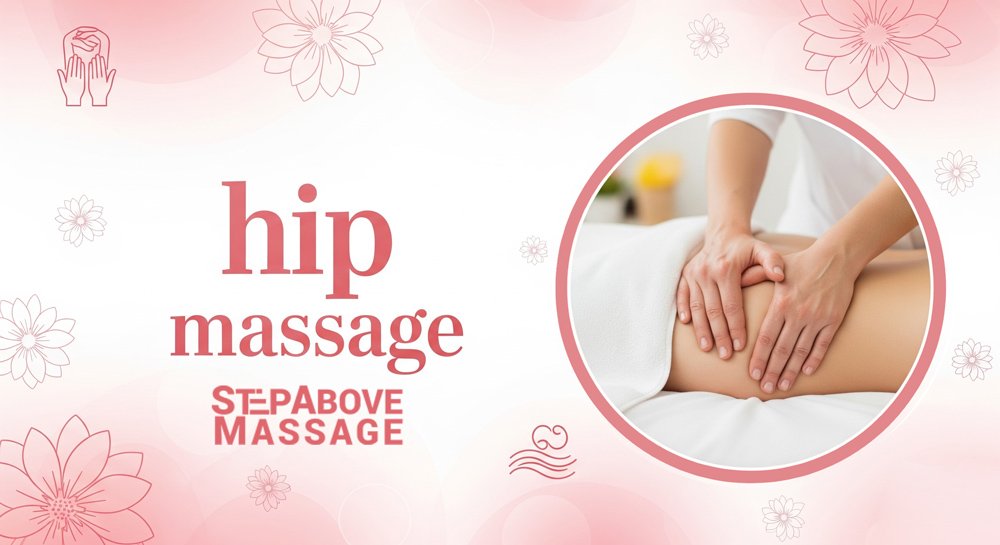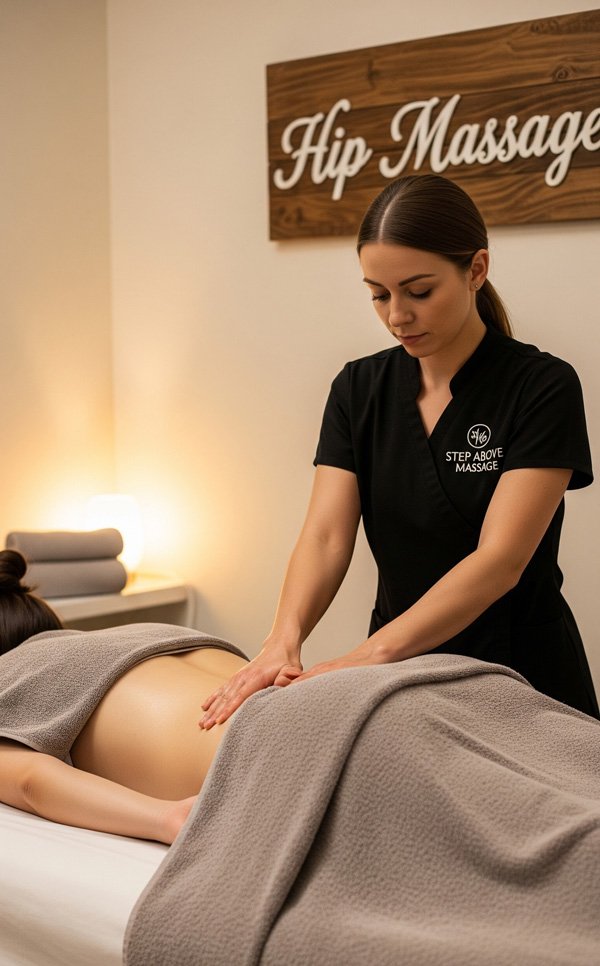
Table of Contents
ToggleThe Definitive Guide to Hip Massage for Lasting Pain Relief and Mobility
Hip massage is a powerful, transformative approach to alleviating chronic hip pain, easing muscular tension, and restoring your natural range of motion. By targeting the intricate network of muscles, joints, and connective tissues in the pelvic region, therapeutic massage addresses both the symptoms and the underlying causes of your discomfort. This is what makes the treatment offered at Step Above Massage a true step above standard therapy. This comprehensive guide explores the common culprits behind hip pain, explains how manual therapy provides relief, and details effective techniques for treatment, offering a definitive resource for reclaiming your mobility and living pain-free
Understanding the Root of Your Hip Discomfort
The hips are the powerhouse of the body, central to fundamental movements like walking, sitting, and bending. Their constant workload, however, makes them susceptible to strain, stiffness, and pain. Identifying the source of the problem is the first step toward effective, lasting relief through massage.
Degenerative Conditions and Systemic Issues
The pelvic girdle and its associated joints can be affected by a variety of degenerative and systemic health problems. Conditions like arthritis and arthrosis can degrade the protective cartilage and bone surfaces, leading to inflammation, stiffness, and chronic ache. Bursitis, which is the irritation of the fluid-filled sacs that cushion the joint, can cause sharp, intense pain and significant swelling, often resulting from mechanical injury or infection. For those suffering from this, knowing how to approach massage for hip bursitis is critical to avoid aggravating the inflammation.
Similarly, tendonitis involves inflammation of the strong ligaments around the pelvis and legs, which severely restricts movement. In some cases, discomfort stems from congenital bone development issues. It’s also important to recognize that pain can be referred from nearby systems, such as the genitourinary or gastrointestinal tracts, or from masses pressing on sensitive nerves, complicating hip function.
Muscular Strain and Biomechanical Stress
Beyond underlying health conditions, a significant amount of hip pain originates from muscular tension, trigger points, and past trauma. Over time, adhesions and “knots” can form in tendons, ligaments, and key muscles like the hip flexors, adductors, or the gluteus medius. These tight bands of tissue can restrict normal blood flow, leading to inflammation, reduced mobility, and persistent pain. These biomechanical issues are especially common in athletes due to overuse, office workers who remain seated for long periods, or individuals with poor postural habits, making therapeutic massage for hip pain an essential tool for restoring function.

The Therapeutic Power of Hip Massage
Hip massage therapy offers a natural, non-invasive path to healing. It effectively addresses discomfort by targeting adhesions, improving circulation, and promoting the body’s own repair mechanisms, making it particularly beneficial for issues affecting the hip joint and its surrounding musculature.
Releasing Adhesions and Restoring Joint Mobility
One of the primary benefits of hip massage is its ability to break down painful adhesions in the soft tissues. This manual manipulation directly reduces tension and releases trigger points, especially in the gluteus medius and minimus muscles, which are common sources of hip and lower back pain. By applying targeted, deep pressure, a skilled therapist can release restrictions in tendons and ligaments, which in turn alleviates inflammation and restores healthy blood flow. This process is fundamental to how you massage hip muscles to achieve greater flexibility. While some initial soreness in the hips, lower back, or buttocks can occur in early sessions, this typically fades as therapy continues, leading to profound and lasting relief.
Boosting Circulation and Enhancing Flexibility
A thorough hips massage significantly promotes blood flow to the treated areas. This enhanced circulation delivers a fresh supply of oxygen and vital nutrients to strained tissues, accelerating recovery from both acute trauma and chronic overuse. This key benefit of massage for the hip area supports a greater range of motion, making daily activities like squatting, climbing stairs, or simply getting up from a chair feel easier and less painful. Furthermore, treatments like a hip flexor massage or a psoas massage trigger the release of endorphins—the body’s natural painkillers—which helps manage the stress of chronic pain and elevates your mood.
Promoting Long-Term Joint Health and Alignment
Regular massage therapy plays a crucial role in maintaining long-term joint health. By correcting muscular imbalances, it fosters better posture and alignment, which reduces the compensatory strains that can worsen conditions like hip arthritis. Specialized techniques such as a psoas release massage or a hip adductor massage are excellent complements to other treatments like physical therapy, helping to prevent flare-ups and promote deep relaxation. This holistic approach contributes to overall wellness, often leading to better sleep and improved immune function.
Professional Hip Massage Techniques Explained
Applying the correct massage techniques is vital for achieving effective and safe relief. A professional therapist will assess your specific restrictions and use targeted methods to restore balance and mobility to the hip joint.
Addressing the External Rotator Group
The hip external rotators are a group of muscles responsible for turning your leg outward. This powerful group includes the well-known gluteus maximus and sartorius, along with deeper muscles like the piriformis, the gemellus superior and inferior, the obturator internus and externus, and the quadratus femoris. These muscles connect the pelvis to the femur, and tension here, particularly in the piriformis, can compress the sciatic nerve and lead to sciatica-like symptoms. A therapist will evaluate restrictions by gently testing your range of motion and then apply passive release techniques to lengthen these tissues and improve outward rotation of the hip.
Focusing on the Internal Rotator Muscles
Responsible for turning the thigh inward, the hip internal rotators are also crucial for balanced movement. The primary muscles in this group are the tensor fasciae latae (TFL) and the anterior fibers of the gluteus medius and minimus. Tightness in these muscles is a common cause of hip pain and can affect your gait. Treatment involves careful assessment of your internal rotation capacity, followed by targeted pressure and passive movement to release tension in the TFL and surrounding tissues, ensuring a significant improvement in the hip’s overall range of motion.
Empowering Self-Care: How to Massage Your Hips at Home
For consistent relief and maintenance between professional sessions, learning how to massage your own hip area at home can be incredibly beneficial.
Getting Started with Hands-On Techniques
Begin by warming up the area with broad, circular motions using your palm to increase blood flow. Then, use your thumbs or the heel of your hand to apply gentle, sustained pressure to tender spots you find around the hip, particularly in the fleshy part of the gluteus medius or the front of the hip flexors. Hold the pressure for 30-60 seconds until you feel the muscle begin to relax.
Essential Tools for Deeper Relief
For deeper and more targeted work, self-massage tools can be a game-changer. A foam roller is excellent for addressing the larger muscles of the hip and thigh, while a massage ball can pinpoint stubborn knots in the glutes. For reaching the notoriously deep psoas muscle, specialized tools like the Psoas Rite can be very effective. Many people also find significant relief using an electric massager for hip pain. For those with arthritic conditions, using a hip massager with heat can be especially soothing, as the warmth helps to relax muscles and ease joint stiffness. The best hip massager for you will depend on the specific area you need to target.
Pairing Massage with Gentle Stretches
After self-massage, always perform gentle stretches like leg extensions or hip rotations. This helps to maintain the newfound flexibility and prevents the muscles from tightening up again, maximizing the benefits of your efforts.
Key Anatomical Structures in Hip Treatment
For a safe and effective treatment, it’s crucial to understand the anatomy of the hip region. A modern, multimodal approach integrates various rehabilitation techniques tailored to an individual’s specific needs.
The Major Muscle Groups to Consider
Effective hip treatment focuses on several key neurovascular and fascial structures. This includes the iliopsoas group (iliacus and psoas major), the hip adductors on the inner thigh (adductor brevis, longus, and magnus, pectineus, and gracilis), the deep external rotators (piriformis and others), the quadriceps at the front of the thigh, and the complete gluteal group (gluteus maximus, medius, minimus, and the TFL). Imbalances or restrictions in any of these structures can contribute to hip dysfunction and pain.
A Holistic, Multimodal Approach to Care
The best type of massage for hip pain is often part of a larger, comprehensive treatment plan. This multimodal approach combines manual therapies, such as deep tissue hip massage or myofascial release, with other effective techniques. These may include neurodynamic mobilization to free up nerves, joint mobilizations to improve movement, and a remedial loading program with specific stretching or strengthening exercises. This integrated strategy also addresses psychosocial factors, like fear of movement, ensuring that the treatment is effective, minimizes risks, and prevents issues like post-massage hip pain.
Building a Routine for Lasting Hip Wellness
To move beyond temporary fixes and achieve sustained comfort, consistency is paramount. Integrating therapeutic practices into your regular routine is the key to preventing recurring discomfort and maintaining a healthy, mobile body.
Consistency is the Foundation of Health
Make hip care a regular part of your life. Schedule consistent sessions with a qualified professional, which you can easily find by searching for a “hip massage near me,” to get targeted, expert care. At home, create a routine using a foam roller or your preferred hip massager tool. This consistent attention prevents minor tightness from becoming a major problem.
Beyond Massage: Supporting Your Hips Every Day
To maximize the benefits of massage therapy, integrate it with complementary wellness practices. Strengthening exercises for your core, glutes, and hips will provide better support for the joint. Practices like yoga or physical therapy can improve alignment and body awareness. Pay attention to your daily habits as well; wearing supportive footwear and maintaining mindful posture while sitting and standing will dramatically reduce strain on your hips. By adopting these habits, you transform temporary relief into a new standard of sustained comfort, allowing you to move through life freely and confidently.
Surprising Facts About Your Hip Muscles
The Body's Largest (and Laziest) Muscle
While the gluteus maximus is the single largest muscle in the human body by volume, it’s surprisingly inactive during routine activities like standing or walking lightly. Its primary job is to generate immense force for powerful movements like climbing stairs, running, or standing up from a squat. For this reason, it’s often referred to as an “anti-gravity” muscle that’s only fully engaged when significant power is needed.
The Hidden Connection to Back Pain
The hip flexors, particularly the iliopsoas, are often called the “hidden prankster” of the lower back. Because they attach from the femur to the lumbar (lower) spine, chronic tightness—common in people who sit for long periods—can pull the pelvis forward into a position called anterior pelvic tilt. This tilt increases the curve in the lower back (lordosis) and places significant strain on the spinal discs and vertebrae, making tight hip flexors a primary, yet often overlooked, cause of chronic lower back pain.
The Crucial Stabilizer for Walking
The gluteus medius, located on the side of the hip, is the key muscle for pelvic stabilization when you’re on one leg. Every time you take a step, the gluteus medius on your standing leg contracts to keep your pelvis level. If this muscle is weak, the opposite hip will drop down with each step, a condition known as a Trendelenburg gait. This weakness is a common source of hip, knee, and IT band issues because it forces other muscles to compensate improperly.
conclusion
Ultimately, understanding the source of your hip pain is the first step toward lasting relief, and as we’ve explored, targeted massage therapy is one of the most effective ways to restore mobility, release tension, and support your long-term joint health. You don’t have to let discomfort dictate your life. If you’re ready to take control and experience the profound benefits of expert care, we invite you to visit our clinic in North Carolina. Let our licensed therapists design a personalized hip massage treatment to help you move freely and confidently again. Book your session today and start your journey back to a balanced, pain-free body.
Frequently Asked Questions
How do you release really tight hips?
Releasing tight hips involves a combination of consistent stretching, targeted self-massage with tools like foam rollers, and professional deep tissue massage. Focusing on the glutes, hip flexors, and rotator muscles is key to restoring flexibility.
Can hip flexors be massaged?
Yes, absolutely. Massaging the hip flexors, particularly the psoas and iliacus muscles, is highly effective for relieving tightness caused by prolonged sitting or athletic activity. It helps reduce lower back pain and improves posture.
What emotion is stored in hip flexors?
In holistic and mind-body practices, the hip flexors (especially the psoas muscle) are often associated with storing stress, fear, and anxiety. This is linked to the body’s primal “fight or flight” response, causing these muscles to clench during moments of tension.
How do you self-release a hip flexor?
To self-release your hip flexor, lie on your stomach and place a firm massage ball just to the inside of your hip bone. Gently sink your weight onto the ball until you feel a tender spot, then hold the pressure and breathe deeply for 30-60 seconds. Avoid placing pressure directly on your abdomen or major arteries.



